Laboratories
- Back
- Top > Laboratories > Musculoskeletal and Cutaneous Surgery > Orthopaedics/Rheumatology
Musculoskeletal and Cutaneous SurgeryOrthopaedics/Rheumatology
Introduction
Orthopedics is the medical specialty that focuses on congenital and acquired diseases and traumas in the locomotive system consisting of bones, cartilages, muscles, tendons, ligaments, and spinal and peripheral nervous system. Orthopedic surgeons care for patients of all ages, from newborns with congenital deformity to elderly persons with degenerative arthritis, by nonsurgical and surgical modalities. In Japan, now entering the stage of 'super-aged society', elucidation of pathophysiology and therapeutic development for the locomotive syndrome is an urgent issue to extend healthy-life span of the elderly. Basic medical research on the special problems of the musculoskeletal system is currently centered around orthopedics.
Our department of orthopaedic surgery consists of six subspecialties including spine surgery, hip arthroplasty surgery, rheumatology, pediatric orthopedics, arthroscopic surgery and sports medicine, and musculoskeletal oncology. Each subspecialty group cooperates with each other to provide better medical care and tackles a broad range of individual problems to innovate treatment strategies. Recent progress in molecular genetics/biology and regenerative medicine will make it possible to unravel pathophysiology/etiology for spinal cord injury, cartilage degeneration, and bone dysplasia, which have been hardly addressed so far, and to develop definitive therapies for them. Up until now, and in the future, our department is dedicated to translational research in order to conquer the intractable conditions of our musculoskeletal systems.
Research Projects
1. Pediatric Orthopedics
i) Transplantation of culture expanded bone marrow cells and platelet-rich plasma in distraction osteogenesis of the long bones
We have developed a unique stem cell-based cell therapy in order to shorten the entire treatment period and reduce the rate of complications in bone lengthening by distraction osteogenesis. Undifferentiated mesenchymal cells that are extracted from bone marrow aspirates are cultured for three weeks with osteogenic medium to differentiate into osteoblast-like cells. Bone-forming osteoblast-like cells and platelet-rich plasma are simultaneously injected into the distracted bone gap. The platelet-rich plasma serves as a scaffold for the osteoblast-like cells because it gelates by addition of thrombin and calcium. This cell therapy was approved as an advanced medicine by MHLW in 2011. This therapy reduced the treatment period by two months on average and significantly decreased the rate of complications.
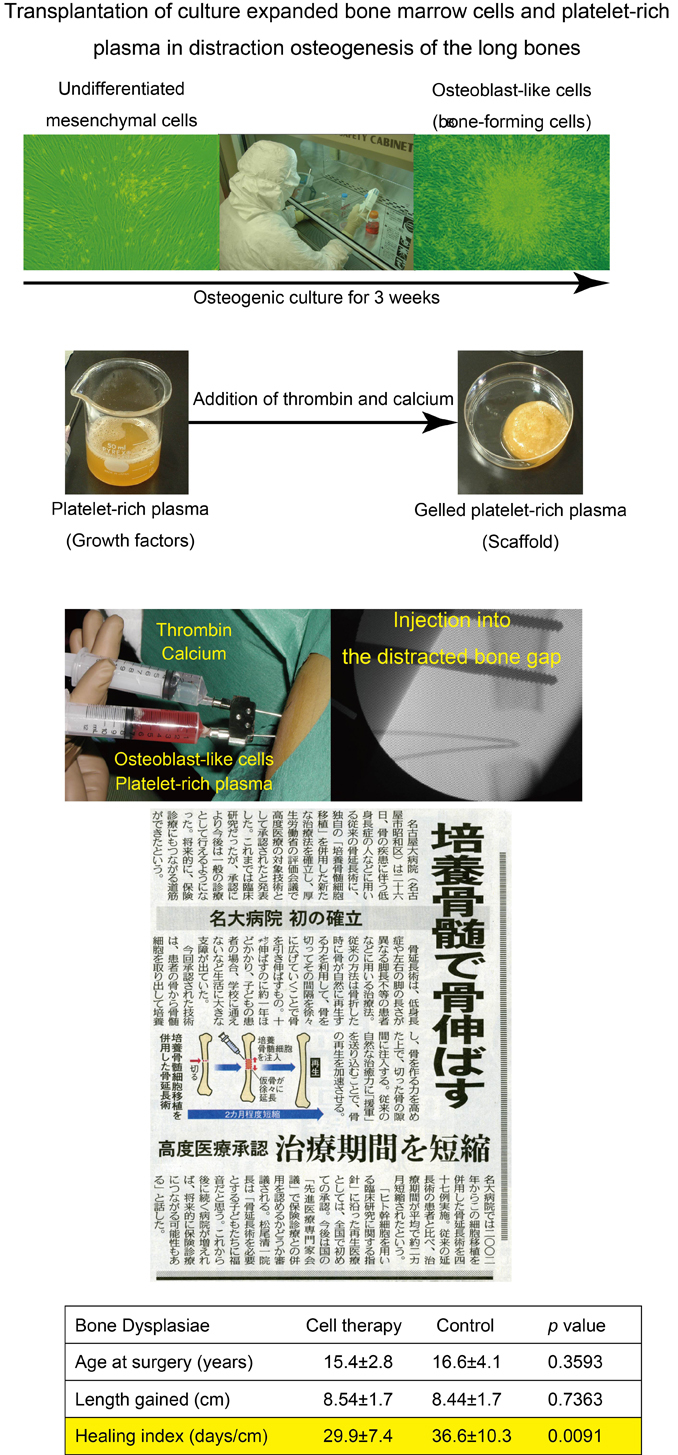
Overview and clinical results regarding transplantation of culture expanded bone marrow cells and platelet-rich plasma in distraction osteogenesis of the long bones
ii) Drug repositioning for achondroplasia
Achondroplasia (ACH) is a short-limbed skeletal dysplasia caused by gain-of-function mutations in the fibroblast growth factor receptor 3 (FGFR3) gene. By comprehensive screening of FDA-approved drugs, we identified that meclozine, an over-the-counter drug for motion sickness, inhibited FGFR3 signaling in chondrocytes. Additionally, meclozine promoted longitudinal bone growth in transgenic ACH mice (). We are currently investigating the optimal dose of meclozine for the treatment of short stature in ACH for further clinical feasibilities.

Meclozine significantly increased longitudinal bone length
2. Rheumatology
i) Tsurumai Biologics Communication Registry: TBCR
Biologic agents have proven to be effective against rheumatoid arthritis (RA) in clinical trials and post-marketing surveillance (PMS) studies. However, limited follow-up periods and strict criteria for recruitment might lead to an underestimation of adverse events. To document the long-term course of patients with RA treated with biologics in clinical settings, we established the Tsurumai Biologics Communication Registry (TBCR). Thus far, eighteen institutes have joined the registry and over 3,000 patients have been identified.
ii) Tocilizumab treatment with Reducing and stopping methotreXate in patients with rheumatoid arthritis in stable low disease activity-state: T-ReX study
This is a prospective, multicenter, non-randomized, single-arm study to assess whether low disease activity would be sustained with reducing and stopping methotrexate (MTX) in patients with rheumatoid arthritis treated with tocilizumab. The primary endpoint is proportion of patients maintaining CDAI ≤ 10 at 36 weeks (24weeks after stopping MTX).
3. Arthroscopic surgery and sports medicine
i) Relationship between tendinopathy and angiogenesis
It is reported that hypervascularity may be one of the reasons of chronic pain in tendinopathic tendon, but tendon vascularization is not fully understood. To date, some lineage-specific factors such as Scleraxis (SCX) and Tenomodulin (TNMD) have been reported as markers of tenocyte differentiation, but few studies have focused on relation of these factors and angiogenic factors. We are studying about the relation of tendon-related genes and angiogenesis-related genes in cells. Human tendon derived cells are cultured from pieces of hamstring tendons during the anterior cruciate ligament reconstruction surgery. When they are treated with IL-1β, tendon-specific marker expressions are decreased and angiogenic marker expressions are increased. And more, angiogenic markers are well increased by the down regulation of SCX with siRNA. These results suggest that SCX may play a major role as an anti-angiogenic factor in tendon.

Human tendon derived cells from tendon tissues
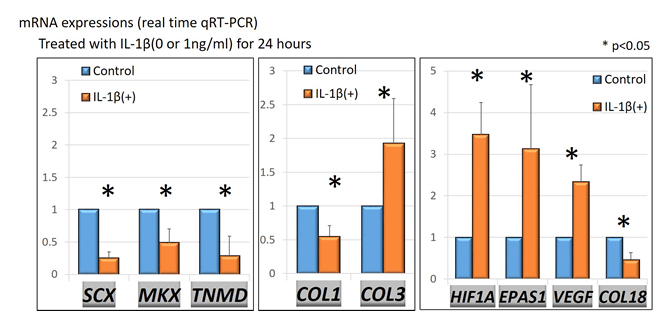
mRNA expressions treated with IL-1β
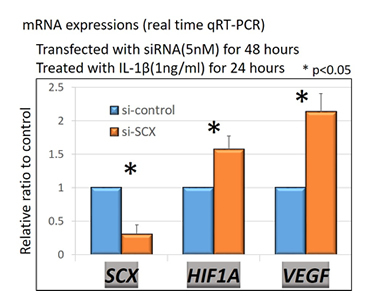
Angiogenic markers are increased by the down regulation of SCX with siRNA
ii) Regulation of expression of the tendon markers through Wnt/β-catenin signaling
Wnt/β-catenin signaling is reported to play a role in development, differentiation and homeostasis. Recently, there are some reports demonstrating the up-regulations of Wnt/β-catenin signaling proteins in tendon tissues. Therefore, it is important to research effects of Wnt/β-catenin signaling on expression of tendon markers such as Scleraxis, Mohawk or Tenomodulin. We demonstrated that activators for Wnt/β-catenin signaling significantly suppressed expressions of tendon markers in rat tendon derived cells and human tendon progenitor cell line. On the other hand, inhibitors for Wnt/β-catenin signaling increased expressions of tendon markers in same cells. In addition, IWR cancelled reduction of tendon marker expressions by human recombinant Wnt3a. Now, we are researching mechanism of how Wnt/β-catenin signaling regulates tendon markers.
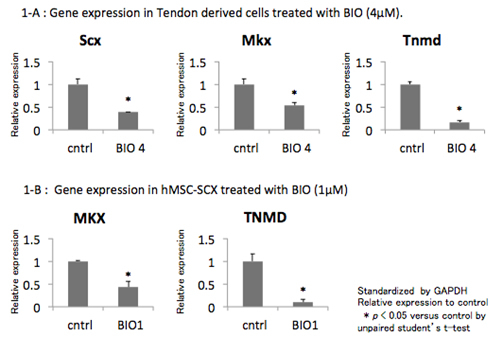
Gene expressions of tendon markers were increased by BIO, an activator for Wnt/β-catenin signaling
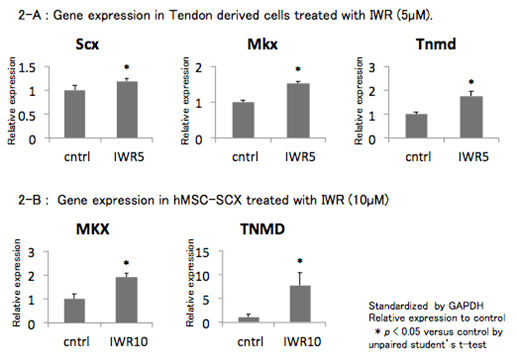
Gene expressions of tendon markers were reduced by IWR, an inhibitor for Wnt/β-catenin signaling
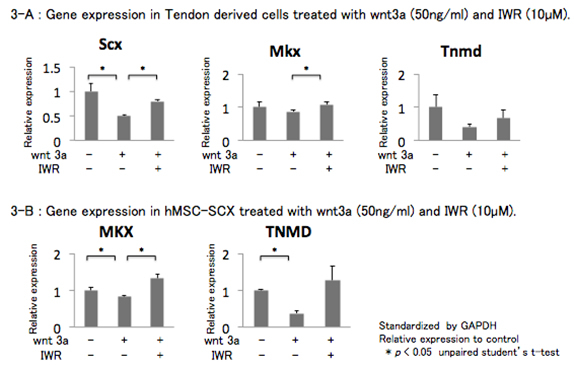
IWR cancelled reduction of tendon marker expressions by human recombinant Wnt3a
4. Musculoskeletal Oncology
i) CTNNB1 mutation analysis for desmoid-type fibromatosis
It has been considered that the majority of desmoid-type fibromatosis has the somatic mutation of β-catenin gene (CTNNB1) which causes nuclear accumulation of β-catenin. Its mutation status has been reported to affect the efficacy of medical treatment and the recurrence rate after surgical resection. Currently, we are performing the CTNNB1 mutation analysis for all cases of desmoid-type fibromatosis, and aim for the establishment of therapeutics algorithm which leads the optimal treatment by the mutation status, location and age. And we have been conducting some collaborative researchers on the whole exome sequencing using a next-generation high-speed sequencer and the preparation of animal model with the institute of medical science, the University of Tokyo and Aichi cancer center research institute
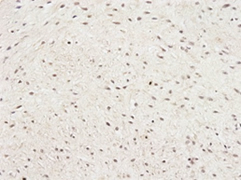
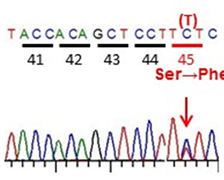
left; The nuclear accumulation of β-catenin, right; The mutation in CTNNB1 exon3 (S45F)
ii) Bone formation by hyperthermia
We reported about the effect of hyperthermia treatment (43-46℃) on the osteogenesis in a rat tibial model with magnetite cationic liposomes (MCL). Our results demonstrate for the first time that heat stimulus accelerates osteogenesis in vivo, and may thus be of interest as a novel and promising tool to induce osteogenesis clinically as well. We are planning a doctor-initiated clinical trial for the clinical applications, using the drug, artificial bone, and the heating device already available for the clinical scene.
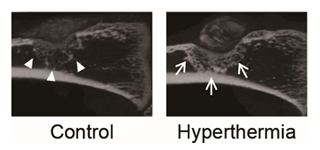
The bone formation by hyperthermia (rat tibial bone defect model)
Faculty Members
| Faculty | Position | Department |
|---|---|---|
| Naoki Ishiguro | Professor | Orthopaedics |
| Yoshihiro Nishida | Designated Professor | Orthopaedics |
| Hiroshi Kitoh | Associate Professor | Orthopaedics |
| Toshihisa Kojima | Lecturer | Orthopaedics |
| Tadahiro Sakai | Lecturer | Orthopaedics |
| Shiro Imagama | Lecturer | Orthopaedics |
| Hideki Hiraiwa | Lecturer | Orthopaedics |
| Nobunori Takahashi | Lecturer | Orthopaedics |
| Hiroshi Urakawa | Lecturer | Orthopaedics |
| Takashi Hamada | Assistant Professor | Orthopaedics |
| Taisuke Seki | Assistant Professor | Orthopaedics |
| Kei Ando | Assistant Professor | Orthopaedics |
| Kazuyoshi Kobayashi | Assistant Professor | Orthopaedics |
| Eisuke Arai | Assistant Professor | Orthopaedics |
| Masaki Matsushita | Assistant Professor | Orthopaedics |
| Satoshi Yamashita | Assistant Professor | Medical IT center |
| Kenichi Mishima | Assistant Professor | Developmental disability medicine |
| Izumi Kadono | Assistant Professor | Rehabilitation |
Bibliography
- 2016
- Amano T, Hasegawa Y, Seki T, Takegami Y, Murotani K, Ishiguro N. A pre-operative predictive score for the outcome of eccentric rotational acetabular osteotomy in the treatment of acetabular dysplasia and early osteoarthritis of the hip in adults. Bone Joint J, 2016; 98-B: 1326-1332.
- Amano T, Hasegawa Y, Seki T, Takegami Y, Murotani K, Ishiguro N. Preoperative prognosis score is a useful tool regarding eccentric rotational acetabular osteotomy in patients with acetabular dysplasia. J Orthop Sci, 2016; 21: 348-353.
- Takegami Y, Seki T, Kaneuji A, Nakao A, Hasegawa Y, Ishiguro N. Validity of a tablet computer version of the Japanese Orthopaedic Association hip disease evaluation questionnaire: a pilot study. Nagoya J Med Sci, 2016; 78: 237-244.
- Osawa Y, Hasegawa Y, Seki T, Amano T, Higuchi Y, Ishiguro N. Significantly Poor Outcomes of Total Hip Arthroplasty After Failed Periacetabular Osteotomy. J Arthroplasty, 2016; 31: 1904-1909.
- Komatsu D, Hasegawa Y, Kojima T, Seki T, Higuchi Y, Ishiguro N. Absence of a relationship between joint space narrowing and osteophyte formation in early knee osteoarthritis among Japanese community-dwelling elderly individuals: A cross-sectional study. Mod Rheumatol, 2016; 14: 1-8.
- Hamada S, Urakawa H, Kozawa E, Arai E, Ikuta K, Sakai T, Ishiguro N, Nishida Y. Characteristics of cultured desmoid cells with different CTNNB1 mutation status. Cancer Med, 2016; 5: 352-60.
- Oda T, Sakai T, Hiraiwa H, Hamada T, Ono Y, Nakashima M, Ishizuka S, Matsukawa T, Yamashita S, Tsuchiya S, Ishiguro N. Osteoarthritis-derived chondrocytes are a potential source of multipotent progenitor cells for cartilage tissue engineering. Biochem Biophys Res Commun, 2016; 479: 469-475.
- Ono Y, Sakai T, Carroll MJ, Lo IK. Tears of the Subscapularis Tendon: A Critical Analysis Review. JBJS Reviews, 2016. [in press]
- Ishizuka S, Sakai T, Hiraiwa H, Hamada T, Knudson W, Ono Y, Nakashima M, Matsukawa T, Oda T, Takamatsu A, Yamashita A, Ishiguro N. Hypoxia-inducible factor-2α induces expression of type X collagen and matrix metalloproteinases 13 in osteoarthritic meniscal cells. Inflammation Research, 2016; 65: 439-48.
- Matsushita M, Kitoh H, Mishima K, Kadono I, Sugiura H, Hasegawa S, Nishida Y, Ishiguro N. Low bone mineral density in achondroplasia and hypochondroplasia. Pediatr Int, 2016; 58: 705-8.
- Mishima K, Kitoh H, Iwata K, Matsushita M, Nishida Y, Hattori T, Ishiguro N. Clinical Results and Complications of Lower Limb Lengthening for Fibular Hemimmelia: A Report of Eight Cases. Medicine (Baltimore), 2016; 95: e3787.
- Hasegawa S, Kitoh H, Ohkawara B, Mishima K, Matsushita M, Masuda A, Ishiguro N, Ohno K. Tranilast stimulates endochondral ossification by upregulating SOX9 and RUNX2 promoters. Biochem Biophys Res Commun, 2016; 470: 356-61.
- Ikuta K, Ota T, Zhuo L, Urakawa H, Kozawa E, Hamada S, Kimata K, Ishiguro N, Nishida Y. Antitumor effects of 4-Methylumbelliferone, a hyaluronan synthesis inhibitor, on malignant peripheral nerve sheath tumor. Int J Cancer, 2016.
- 2015
- Asai S, Kojima T, Oguchi T, Kaneko A, Hirano Y, Yabe Y, Kanayama Y, TakahashiN, Funahashi K, Hanabayashi M, Hirabara S, Yoshioka Y, Takemoto T, Terabe K, AsaiN, Ishiguro N. Effects of Concomitant Methotrexate on Large Joint Replacement in Patients With Rheumatoid Arthritis Treated With Tumor Necrosis Factor Inhibitors: A Multicenter Retrospective Cohort Study in Japan. Arthritis Care Res (Hoboken), 2015; 67: 1363-70.
- Takahashi N, Kojima T, Kaneko A, Kida D, Hirano Y, Fujibayashi T, Yabe Y,Takagi H, Oguchi T, Miyake H, Kato T, Fukaya N, Hayashi M, Tsuboi S, Kanayama Y, Funahashi K, Hanabayashi M, Hirabara S, Asai S, Yoshioka Y, Ishiguro N. Use of a 12-week observational period for predicting low disease activity at 52 weeks in RA patients treated with abatacept: a retrospective observational study based on data from a Japanese multicentre registry study. Rheumatology (Oxford), 2015; 54: 854-9.
- Kojima T, Yabe Y, Kaneko A, Takahashi N, Funahashi K, Kato D, Hanabayashi M, Asai S, Hirabara S, Asai N, Hirano Y, Hayashi M, Miyake H, Kojima M, Ishiguro N. Importance of methotrexate therapy concomitant with tocilizumab treatment in achieving better clinical outcomes for rheumatoid arthritis patients with highdisease activity: an observational cohort study. Rheumatology (Oxford), 2015; 54: 113-20.
- Nishida Y, Tsukushi S, Urakawa H, Hamada S, Kozawa E, Ikuta K, Ando Y, Ishiguro N. Low-dose chemotherapy with methotrexate and vinblastine for patients with desmoid tumors: relationship to CTNNB1 mutation status. Int J Clin Oncol, 2015; 20:1211-7.
- Ikuta K, Urakawa H, Kozawa E, Hamada S, Ota T, Kato R, Honda H, Kobayashi T, Ishiguro N, Nishida Y. In vivo heat-stimulus-triggered osteogenis. Int J Hyperthermia, 2015; 31: 58-66.
- Omachi T, Sakai T, Hiraiwa H, Hamada T, Ono Y, Nakashima M, Ishizuka S, Matsukawa T, Oda T, Takamatsu A, Yamashita S, Ishiguro N. Expression of tenocyte lineage-related factors in regenerated tissue at sites of tendon defect. J Orthop Sci, 2015; 20: 380-9.
- Matsushita M, Hasegawa S, Kitoh H, Mori K, Ohkawara B, Yasoda A, Masuda A, Ishiguro N, Ohno K. Meclozine promotes longitudinal skeletal growth in transgenic mice with achondroplasia carrying a gain-of-function mutation in the FGFR3 gene. Endocrinology, 2015; 156: 548-54.
- Mishima K. Kitoh H, Kadono I, Matsushita M, Sugiura H, Hasegawa S, Kitamura A, Nishida Y, Ishiguro N. Prediction of Clinically Significant Leg-Length Discrepancy in Congenital Disorders. Orthopedics, 2015; 38: e919-24.
- Mishima K, Kitoh H, Ohkawara B, Okuno T, Ito M, Masuda A, Ishiguro N, Ohno K. Lansoprazole Upregulates Polyubiquitination of the TNF Receptor-Associated Factor 6 and Facilitates Runx2-mediated Osteoblastogenesis. EBioMedicine, 2015; 12: 2046-2061.
- 2014
- Kitoh H, Mishima K, Matsushita M, Nishida Y, Ishiguro N. Early and late fracture following extensive limb lengthening in patients with achondroplasia and hypochondroplasia. Bone Joint J, 2014; 96: 1269-73.
- 2013
- Kitoh H, Achiwa M, Kaneko H, Mishima K, Matsushita M, Kadono I, Horowitz JD, Sallustio BC, Ohno K, Ishiguro N. Perhexiline maleate in the treatment of fibrodysplasia ossificans progressiva: an open-labeled clinical trial. Orphanet J Rare Dis, 2013; 8: 163.
- 2012
- Kojima T, Kaneko A, Hirano Y, Ishikawa H, Miyake H, Oguchi T, Takagi H, Yabe Y, Kato T, Ito T, Terabe K, Fukaya N, Kanayama Y, Shioura T, Funahashi K, HayashiM, Kato D, Matsubara H, Fujibayashi T, Kojima M, Ishiguro N; TBC. Study protocol of a multicenter registry of patients with rheumatoid arthritis starting biologic therapy in Japan: Tsurumai Biologics Communication Registry (TBCR) study. Mod Rheumatol, 2012; 22: 339-45.
- 2011
- Tsuboi M, Hasegawa Y, Matsuyama Y, Suzuki S, Suzuki K, Imagama S. Do musculoskeletal degenerative diseases affect mortality and cause of death after 10 years in Japan? J Bone Miner Metab. 2011; 29: 217-223.
- 2010
- Seki T, Hasegawa Y, Yamaguchi J, Kanoh T, Ishiguro N, Tsuboi M, Ito Y, Hamajima N, Suzuki K. Association of serum carotenoids, retinol, and tocopherols with radiographic knee osteoarthritis: possible risk factors in rural Japanese inhabitants. J Orthop Sci, 2010; 15: 477-484.
Research Keywords
Bone regenerative medicine, Achondroplasia, bone lengthening, Hyperthermia, Desmoid-type fibromatosis, Rheumatoid arthritis, Biologic agent, Tsurumai Biologics Communication Registry, Tendinopathy, Wnt-β-catenin signaling, Eccentric rotational acetabular osteotomy, pre-operative predictive score, Yagumo study